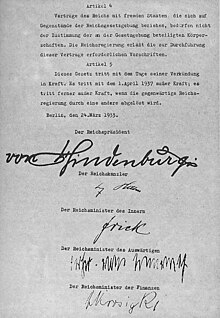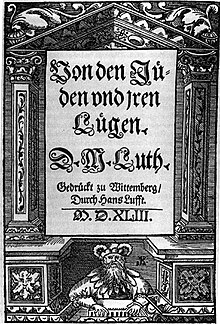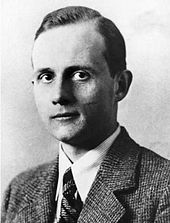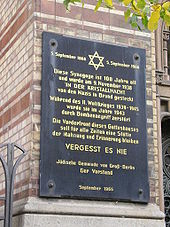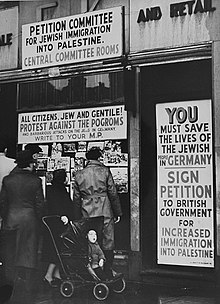Hitler's Reichstag speech promoting the bill was delivered at the Kroll Opera House, following the Reichstag fire.
The Enabling Act (German: Ermächtigungsgesetz) of 1933, formally titled Gesetz zur Behebung der Not von Volk und Reich ("Law to Remedy the Distress of People and Reich"), was a law that gave the German Cabinet—in effect, the Chancellor—the power to enact laws without the involvement of the Reichstag, and to override fundamental aspects of the Weimar Constitution. The Enabling Act gave Hitler plenary powers and followed on the heels of the Reichstag Fire Decree,
which had abolished most civil liberties and transferred state powers
to the Reich government. The combined effect of the two laws was to
transform Hitler's government into a legal dictatorship.
The act passed in both the Reichstag and Reichsrat on 23 March 1933, and was signed by President Paul von Hindenburg later that day. The act stated that it was to last four years unless renewed by the Reichstag, which occurred twice.
The law was enacted by the Reichstag (meeting at the Kroll Opera House), where non-Nazi members were surrounded and threatened by members of the SA and the SS. The Communists had already been repressed and were not allowed to be present or to vote, and some Social Democrats
were kept away as well. In the end most of those present voted for the
act, except for the Social Democrats, who voted against it.
Background
After being appointed Chancellor of Germany on 30 January 1933, Hitler asked President von Hindenburg to dissolve the Reichstag. A general election was scheduled for 5 March 1933. A secret meeting was held between Hitler and 20 to 25 industrialists at the official residence of Hermann Göring in the Reichstag Presidential Palace, aimed at financing the election campaign of the Nazi Party.
The burning of the Reichstag, depicted by the Nazis as the beginning of a communist revolution, resulted in the presidential Reichstag Fire Decree, which among other things suspended freedom of press and habeas corpus rights just five days before the election. Hitler used the decree to have the Communist Party's offices raided and its representatives arrested, effectively eliminating them as a political force.
Although they received five million more votes than in the
previous election, the Nazis failed to gain an absolute majority in
parliament, and depended on the 8% of seats won by their coalition
partner, the German National People's Party, to reach 52% in total.
To free himself from this dependency, Hitler had the cabinet, in
its first post-election meeting on 15 March, draw up plans for an
Enabling Act which would give the cabinet legislative power for four
years. The Nazis devised the Enabling Act to gain complete political
power without the need of the support of a majority in the Reichstag and without the need to bargain with their coalition partners.
Preparations and negotiations
The
Enabling Act allowed the cabinet to enact legislation, including laws
deviating from or altering the constitution, without the consent of the Reichstag.
Because this law allowed for departures from the constitution, it was
itself considered a constitutional amendment. Thus, its passage required
the support of two-thirds of those deputies who were present and
voting. A quorum of two-thirds of the entire Reichstag was required to be present in order to call up the bill.
The Social Democrats (SPD) and the Communists (KPD) were expected
to vote against the Act. The government had already arrested all
Communist and some Social Democrat deputies under the Reichstag Fire
Decree. The Nazis expected the parties representing the middle class,
the Junkers and business interests to vote for the measure, as they had grown weary of the instability of the Weimar Republic and would not dare to resist.
Hitler believed that with the Centre Party members' votes, he would get the necessary two-thirds majority. Hitler negotiated with the Centre Party's chairman, Ludwig Kaas,
a Catholic priest, finalising an agreement by 22 March. Kaas agreed to
support the Act in exchange for assurances of the Centre Party's
continued existence, the protection of Catholics' civil and religious
liberties, religious schools and the retention of civil servants
affiliated with the Centre Party. It has also been suggested that some
members of the SPD were intimidated by the presence of the Nazi Sturmabteilung (SA) throughout the proceedings.
Some historians, such as Klaus Scholder, have maintained that Hitler also promised to negotiate a Reichskonkordat
with the Holy See, a treaty that formalised the position of the
Catholic Church in Germany on a national level. Kaas was a close
associate of Cardinal Pacelli, then Vatican Secretary of State (and
later Pope Pius XII).
Pacelli had been pursuing a German concordat as a key policy for some
years, but the instability of Weimar governments as well as the enmity
of some parties to such a treaty had blocked the project. The day after the Enabling Act vote, Kaas went to Rome in order to, in
his own words, "investigate the possibilities for a comprehensive
understanding between church and state". However, so far no evidence for a link between the Enabling Act and the Reichskonkordat signed on 20 July 1933 has surfaced.
Text
As with most of the laws passed in the process of Gleichschaltung, the Enabling Act is quite short, especially considering its implications. The full text, in German and English, follows:
| Gesetz zur Behebung der Not von Volk und Reich | Law to Remedy the Distress of the People and the Reich |
| Der Reichstag hat das folgende Gesetz beschlossen, das mit Zustimmung des Reichsrats hiermit verkündet wird, nachdem festgestellt ist, daß die Erfordernisse verfassungsändernder Gesetzgebung erfüllt sind: | The Reichstag has enacted the following law, which is hereby proclaimed with the assent of the Reichsrat, it having been established that the requirements for a constitutional amendment have been fulfilled: |
| Artikel 1 | Article 1 |
| Reichsgesetze können außer in dem in der Reichsverfassung vorgesehenen Verfahren auch durch die Reichsregierung beschlossen werden. Dies gilt auch für die in den Artikeln 85 Abs. 2 und 87 der Reichsverfassung bezeichneten Gesetze. | In addition to the procedure prescribed by the constitution, laws of the Reich may also be enacted by the government of the Reich. This includes the laws referred to by Articles 85 Paragraph 2 and Article 87 of the constitution. |
| Artikel 2 | Article 2 |
| Die von der Reichsregierung beschlossenen Reichsgesetze können von der Reichsverfassung abweichen, soweit sie nicht die Einrichtung des Reichstags und des Reichsrats als solche zum Gegenstand haben. Die Rechte des Reichspräsidenten bleiben unberührt. | Laws enacted by the government of the Reich may deviate from the constitution as long as they do not affect the institutions of the Reichstag and the Reichsrat. The rights of the President remain unaffected. |
| Artikel 3 | Article 3 |
| Die von der Reichsregierung beschlossenen Reichsgesetze werden vom Reichskanzler ausgefertigt und im Reichsgesetzblatt verkündet. Sie treten, soweit sie nichts anderes bestimmen, mit dem auf die Verkündung folgenden Tage in Kraft. Die Artikel 68 bis 77 der Reichsverfassung finden auf die von der Reichsregierung beschlossenen Gesetze keine Anwendung. | Laws enacted by the Reich government shall be issued by the Chancellor and announced in the Reich Gazette. They shall take effect on the day following the announcement, unless they prescribe a different date. Articles 68 to 77 of the Constitution do not apply to laws enacted by the Reich government. |
| Artikel 4 | Article 4 |
| Verträge des Reiches mit fremden Staaten, die sich auf Gegenstände der Reichsgesetzgebung beziehen, bedürfen für die Dauer der Geltung dieser Gesetze nicht der Zustimmung der an der Gesetzgebung beteiligten Körperschaften. Die Reichsregierung erläßt die zur Durchführung dieser Verträge erforderlichen Vorschriften. | Treaties of the Reich with foreign states, which relate to matters of Reich legislation, shall for the duration of the validity of these laws not require the consent of the legislative authorities. The Reich government shall enact the legislation necessary to implement these agreements. |
| Artikel 5 | Article 5 |
| Dieses Gesetz tritt mit dem Tage seiner Verkündung in Kraft. Es tritt mit dem 1. April 1937 außer Kraft; es tritt ferner außer Kraft, wenn die gegenwärtige Reichsregierung durch eine andere abgelöst wird. | This law enters into force on the day of its proclamation. It expires on 1 April 1937; it expires furthermore if the present Reich government is replaced by another. |
Articles 1 and 4 gave the government the right to draw up the budget and approve treaties without input from the Reichstag.
Act (page 1)
Act (page 2 with signatures)
Passage
Debate
within the Centre Party continued until the day of the vote, 23 March
1933, with Kaas advocating voting in favour of the act, referring to an
upcoming written guarantee from Hitler, while former Chancellor Heinrich Brüning
called for a rejection of the Act. The majority sided with Kaas, and
Brüning agreed to maintain party discipline by voting for the Act.
The Reichstag, led by its President, Hermann Göring, changed its rules of procedure to make it easier to pass the bill. Under the Weimar Constitution, a quorum
of two-thirds of the entire Reichstag membership was required to be
present in order to bring up a constitutional amendment bill. In this
case, 432 of the Reichstag's 647 deputies would have normally been
required for a quorum. However, Göring reduced the quorum to 378 by not
counting the 81 KPD deputies. Despite the virulent rhetoric directed
against the Communists, the Nazis did not formally ban the KPD right
away. Not only did they fear a violent uprising, but they hoped the
KPD's presence on the ballot would siphon off votes from the SPD.
However, it was an open secret that the KPD deputies would never be
allowed to take their seats; they were thrown in jail as quickly as the
police could track them down. Courts began taking the line that since
the Communists were responsible for the fire, KPD membership was an act
of treason. Thus, for all intents and purposes, the KPD was banned as
of 6 March, the day after the election.
Göring also declared that any deputy who was "absent without
excuse" was to be considered as present, in order to overcome
obstructions. Leaving nothing to chance, the Nazis used the provisions
of the Reichstag Fire Decree to detain several SPD deputies. A few
others saw the writing on the wall and fled into exile.
Later that day, the Reichstag assembled under intimidating circumstances, with SA men swarming inside and outside the chamber. Hitler's speech, which emphasised the importance of Christianity in German culture,
was aimed particularly at appeasing the Centre Party's sensibilities
and incorporated Kaas' requested guarantees almost verbatim. Kaas gave a
speech, voicing the Centre's support for the bill amid "concerns put
aside", while Brüning notably remained silent.
Only SPD chairman Otto Wels
spoke against the Act, declaring that the proposed bill could not
"destroy ideas which are eternal and indestructible." Kaas had still not
received the written constitutional guarantees he had negotiated, but
with the assurance it was being "typed up", voting began. Kaas never
received the letter.
At this stage, the majority of deputies already supported the
bill, and any deputies who might have been reluctant to vote in favour
were intimidated by the SA troops surrounding the meeting. In the end,
all parties except the SPD voted in favour of the Enabling Act. With the
KPD banned and 26 SPD deputies arrested or in hiding, the final tally
was 444 in favour of the Enabling Act against 94 (all Social Democrats)
opposed. The Reichstag had adopted the Enabling Act with the support of
83% of the deputies. The session took place under such intimidating
conditions that even if all SPD deputies had been present, it would have
still passed with 78.7% support. The same day in the evening, the Reichsrat also gave its approval, unanimously and without prior discussion. The Act was then signed into law by President Hindenburg.
Consequences
Under the Act, the government had acquired the authority to pass laws
without either parliamentary consent or control. These laws could (with
certain exceptions) even deviate from the Constitution. The Act
effectively eliminated the Reichstag as active player in German
politics. While its existence was protected by the Enabling Act, for
all intents and purposes it reduced the Reichstag to a mere stage for
Hitler's speeches. It only met sporadically until the end of World War II,
held no debates and enacted only a few laws. Within three months of the
passage of the Enabling Act, all parties except the Nazi Party were
banned or pressured into dissolving themselves, followed on 14 July by a
law that made the Nazi Party the only legally permitted party in the
country. With this, Hitler had fulfilled what he had promised in earlier
campaign speeches: "I set for myself one aim ... to sweep these thirty
parties out of Germany!"
During the negotiations between the government and the political
parties, it was agreed that the government should inform the Reichstag
parties of legislative measures passed under the Enabling Act. For this
purpose, a working committee
was set up, co-chaired by Hitler and Centre Party chairman Kaas.
However, this committee met only three times without any major impact,
and rapidly became a dead letter even before all other parties were
banned.
Though the Act had formally given legislative powers to the
government as a whole, these powers were for all intents and purposes
exercised by Hitler himself. After its passage, there were no longer
serious deliberations in Cabinet meetings. Its meetings became more and
more infrequent after 1934, and it never met in full after 1938.
Due to the great care that Hitler took to give his dictatorship
an appearance of legality, the Enabling Act was renewed twice, in 1937
and 1941. However, its renewal was practically assured since all other
parties were banned. Voters were presented with a single list of Nazis
and Nazi-approved "guest" candidates under far-from-secret conditions.
In 1942, the Reichstag passed a law giving Hitler power of life and
death over every citizen, effectively extending the provisions of the
Enabling Act for the duration of the war.
Ironically, at least two, and possibly three, of the penultimate
measures Hitler took to consolidate his power in 1934 violated the
Enabling Act. In February 1934, the Reichsrat, representing the states,
was abolished even though Article 2 of the Enabling Act specifically
protected the existence of both the Reichstag and the Reichsrat. It can
be argued that the Enabling Act had been breached two weeks earlier by
the Law for the Reconstruction of the Reich,
which transferred the states' powers to the Reich and effectively left
the Reichsrat impotent. Article 2 stated that laws passed under the
Enabling Act could not affect the institutions of either chamber.
In August, Hindenburg died, and Hitler seized the president's
powers for himself in accordance with a law passed the previous day, an
action confirmed via a referendum later that month.
Article 2 stated that the president's powers were to remain
"undisturbed" (or "unaffected", depending on the translation), which has
long been interpreted to mean that it forbade Hitler from tampering
with the presidency. A 1932 amendment to the constitution made the
president of the High Court of Justice, not the chancellor, first in the
line of succession to the presidency—and even then on an interim basis
pending new elections.
However, the Enabling Act provided no remedy for any violations of
Article 2, and these actions were never challenged in court.
In his book, The Coming of the Third Reich, British historian Richard J. Evans
argued that the Enabling Act was legally invalid. He contended that
Göring had no right to arbitrarily reduce the quorum required to bring
the bill up for a vote. While the Enabling Act only required the support
of two-thirds of those present and voting, two-thirds of the entire
Reichstag's membership had to be present in order for the legislature to
consider a constitutional amendment. According to Evans, while Göring
was not required to count the KPD deputies in order to get the Enabling
Act passed, he was required to "recognize their existence" by counting
them for purposes of the quorum needed to call it up, making his refusal
to do so "an illegal act". (Even if the Communists had been present and
voting, the session's atmosphere was so intimidating that the Act would
have still passed with, at the very least, 68.7% support.) He also
argued that the act's passage in the Reichsrat was tainted by the
overthrow of the state governments under the Reichstag Fire Decree; as
Evans put it, the states were no longer "properly constituted or
represented", making the Enabling Act's passage in the Reichsrat
"irregular".
In the Federal Republic of Germany
Article 9 of the German Constitution, enacted in 1949, allows for social groups to be labeled verfassungsfeindlich
("hostile to the constitution") and to be proscribed by the federal
government. Political parties can be labeled enemies to the constitution
only by the Bundesverfassungsgericht (Federal Constitutional Court),
according to Art. 21 II. The idea behind the concept is the notion that
even a majority rule of the people cannot be allowed to install a
totalitarian or autocratic regime such as with the Enabling Act of 1933,
thereby violating the principles of the German constitution.
Portrayal in films
The 2003 film Hitler: The Rise of Evil
contains a scene portraying the passage of the Enabling Act. The
portrayal in the film is inaccurate, with the provisions of the Reichstag Fire Decree
(which in practice, as the name states, was a decree issued by
President Hindenburg weeks before the Enabling Act) merged into the Act.
Non-Nazi members of the Reichstag, including Vice-Chancellor von Papen, are shown objecting. In reality the Act met little resistance, with only the centre-left Social Democratic Party voting against passage.
The same film also shows Hermann Göring, the then speaker of the house, begin singing the "Deutschlandlied".
Nazi representatives then stand and immediately join in with Göring,
all other party members join in too, with everyone performing the Hitler
salute. In reality, this never happened.


